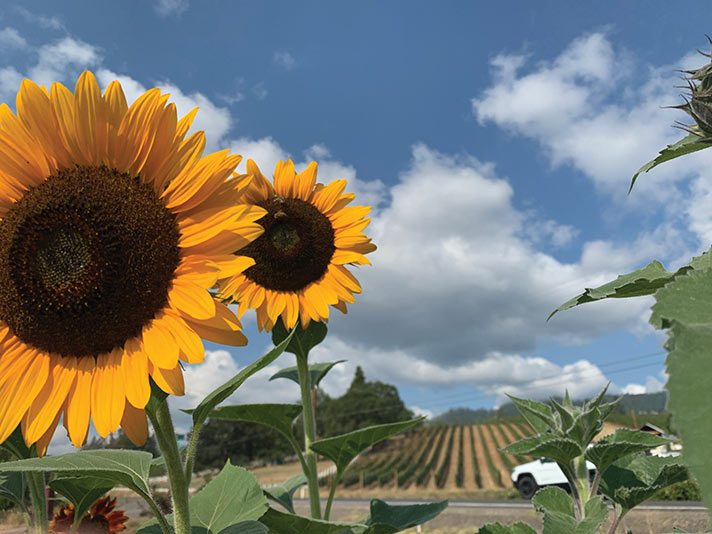On Hemp – August 2022
Years ago, we reviewed the environmental impact of hemp farms. We all found it wanting. They were ugly. Plastic littered the fields and greenhouses. Many were unkempt and an obvious eyesore to neighbors. Few wanted to live next door.
We identified several areas in which we thought we could improve. The first and most glaring is overuse of plastic. No one likes plastic. We all try to move away from it in daily use. But the US is addicted it seems and farming is no different. The most controversial is the use of plastic film barriers on soil beds.
Plastic mulch is used in farming for three reasons—weed control, insulation, and water retention. Plastic films do reasonably well at all three. They keep weeds at bay adjacent to plants, where you can’t mow. Film barriers also warm the soil, meaning you can plant earlier. While warmer soil is initially listed as an advantage, we find that it easily overheats the soil, causing other problems. Mulch is highly effective at reducing evaporation. Studies show up to 70% reduction in irrigation evaporation. In our current drought, that is a huge advantage.
We first pivoted to biodegradable starch-based mulch film. It certainly feels better, but it didn’t address all the problems. Bio film costs about 3 times as much. It does degrade, given time. But from the road, no one knows it is biodegradable. So, the perception of harm remains with the public. When other farms see its use, they don’t know either if it is biodegradable. The presence of film tends to beget others doing the same.
Film can also be a detriment to plant and soil health. On some sunny days, we recorded soil temps below the film of 140F! That kills many of the healthy soil microbes and fungi which feed plants. If we add water during the day, hot and humid conditions around the roots encourage pythium and other root rot problems. When we pulled the film back, we found packed, overheated and barren soil. We began to wonder if use of film mulch was a net advantage at all.
For a solution, we went back to the name. What is plastic “mulch,” but an effort to replicate real mulch such as that in your garden? Composted material that is placed around plants for weed mitigation, insulation and evaporation control is not new. It is tried and true. It doesn’t easily scale, but it can be done.
We brought in 17 tons of straw on a semi-truck. Learning as we went, we developed a technique for building the beds, planting the starts, then protecting young plants while another team spreads a thick blanket of straw over each bed. The results have exceeded our expectations.
Our plants are healthier and more robust than previous seasons. As we pull back the mulch, we find vibrant soil environments at cooled temperatures. We are getting everything the film mulch barriers promised and none of the negative impacts of impermeable film.
There are also some disadvantages. Straw is twice the cost of biodegradable mulch film and 6X that of conventional film. It costs more to apply. It is not as effective against weeds. But is it worth it? Absolutely. Plants are larger. We have no pythium. And the fields look so much nicer. The field has a completely different feel.
A concurrent challenge was how to extend that clean and healthy feel to something neighbors could enjoy from a distance. We needed something that would make both neighbors and insects happy—flowers. Sunflowers, Calendula, Zinnia and Dahlias work well. We plant them at the end of our rows, and on a solid berm along adjacent roads. We add pumpkins and squash for vigorous ground cover, and because a pumpkin patch is a treat during fall harvest.
These flowers oases serve many purposes beyond esthetics. They become “Beetle Banks,” where beneficial insects live and thrive. Clouds of these bugs leave the banks each evening to go to work on harmful insects in our fields. Diverse plants provide dining alternatives to our cash crop. Cucumber beetles once gorged on our youngest plants. Now they cluster on young pumpkin leaves. I rarely find them on hemp plants.
In a time when bee populations are dwindling, these flowers are a respite. By September, the sunflowers are full grown. They are covered with bees sporting thick leggings of pollen. The hedges become home to all manner of fauna, including rabbits and a pair of foxes. I don’t know where these bees and friends were living and eating before, but they clearly enjoy the buffet.
Neighbors like it. We get more positive feedback about those sunflowers than anything else we do. Initially they seemed superfluous. Now they are an essential part of the mix. As we evolve our practices each year, I’m pleased to see how balanced and regenerative farming can be. Esthetics must be essential to life. If it weren’t we wouldn’t care what the landscape looked like. But we do. And flowers are prettier than plastic.
Paul Murdoch grew up in the Rogue Valley. He and his family operated Gary West Smoked Meats before changing focus to CBD and Hemp agriculture. Paul serves on the Oregon Department of Agriculture Hemp Commission. Contact him at paul@horncreekhemp.com or 541-261-4900.
